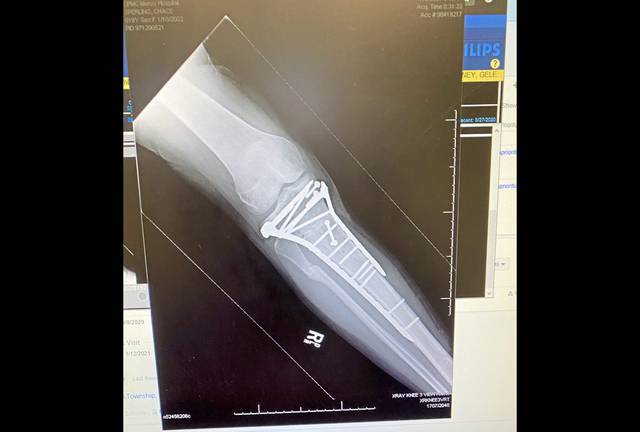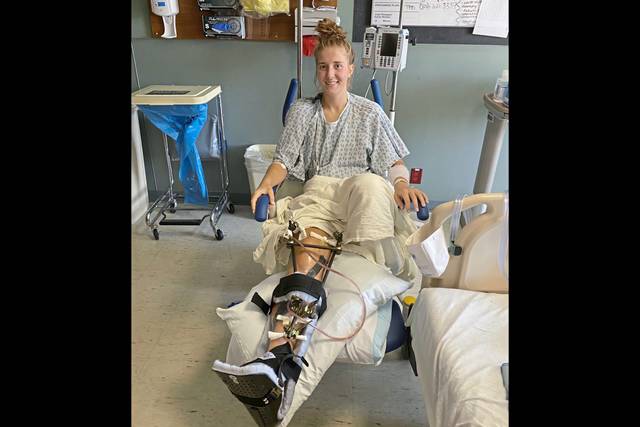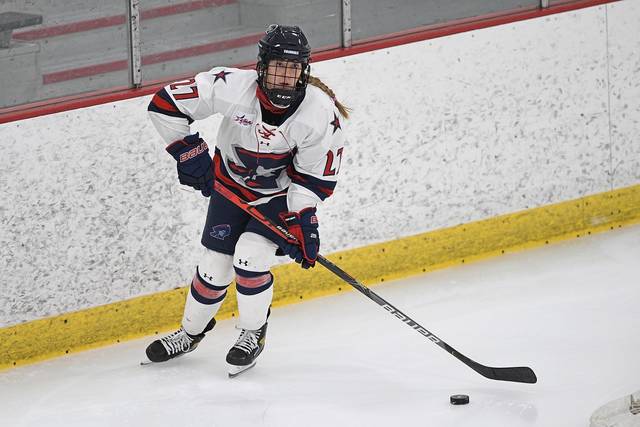'Chace'ing a comeback: From near amputation to NCAA hockey. The remarkable return of RMU's Chace Sperling.
She doesn’t remember much about the 11-day stint at the hospital. It’s all a blur between the four surgeries, 38 stitches, pain medication, monotony and limited visits thanks to the pandemic.
Robert Morris University hockey player Chace Sperling does remember one thing, though. That 20 minutes of agony flat on her back waiting for an ambulance to scrape her off the concrete of the RMU campus.
“I was in shock a bit. But I didn’t pass out. So, that’s good,” Sperling said with a self-reflexive laugh.
Sperling remembers one other thing. Her two teammates ordering her, “Don’t look at it!”
Those are four words no athlete wants to hear. When one of your teammates yells “don’t look at it,” it only means one thing.
It’s even worse than you think.
Sperling’s teammates were too late, anyway. She already looked.
“My leg was stuck in the railing in (the shape of) a backward ‘L,’” Sperling said. “I started crying and screamed for help.”
Maybe at that point, it would have been better to pass out for a second.
Rough start
By Aug. 27, Sperling had been on the Robert Morris campus for all of three days. She was 1,600 miles and 26 hours from her hometown of Theodore, Saskatchewan.
Questions were swirling for the Colonials women’s hockey team. How would the roster shape up? When would the season start? How would coronavirus impact the schedule?
But by the end of the day, Sperling would be asking a different question, “When will I be able to walk again?”
Sperling and her two suitemates — Marah Wagner and Joelle Fiala — decided to go rollerblading.
Ever see the hills on Robert Morris’ campus? Yeah. Exactly.
“I was going down a hill in front of the business center,” Sperling explained last week. “And I didn’t know how to stop because I had no stoppers. And there was no place to go. So I tried to grab onto a railing. And my leg got caught in it. And it just snapped.”
At that point, it was up to Fiala and Wagner to unwrap the badly damaged right leg and extract her from the railing.
“I have never seen anything like how her leg looked,” Wagner said. “Luckily Joelle and I were able to get her legs from under the railing and onto the sidewalk without too much discomfort, so she wasn’t in such an odd position. Then I sat down at her torso, putting my body between her eyesight and legs so she wouldn’t be able to see how bad it actually was.”
Sperling has made some photos of her injury available.
Sperling had suffered what would eventually be diagnosed by UPMC Mercy doctors as a “type III open fracture “(when the bone comes out through the skin) of the tibia and fibula. Sperling also says that she punctured an artery in the leg.
“This is the worst of the worst of what you can get,” Dr. Gele Moloney told me during a phone interview Wednesday.
Moloney performed Sperling’s last three surgeries. She is an assistant professor of orthopedic surgery (division of orthopedic trauma) at UPMC.
At this point, most sports fans are probably going through their mental Rolodex of bad broken legs and ankles they’ve seen in the past. Alex Smith. Joe Theismann. Gordon Hayward. Kevin Ware.
Was Sperling’s akin to those?
“We grade them on a scale of one, two or three. Three being the most severe. Hers was that (type III) level of severity,” Dr. Moloney said.
“The wound that we had to close was over a foot long along the front of her tibia.”
So, yes. Pretty bad.
Say that again?
RMU women’s hockey coach Paul Colontino was told about the injury. Then he waited for over an hour to get an update on how bad the break truly was. When he finally got word, he couldn’t quite process the information.
“They were off to the hospital and we were trying to get things in order … and by later that night our trainer called and said the doctor told them, ‘They’re trying to save the leg.’”
Wait. What? Save the leg? Like perhaps needing an amputation?
“That was the first glimpse of the magnitude of the injury,” Colontino said. “It went to a whole different level. Almost like you had to rewind. Like, how did we get … to here?”
As Dr. Moloney describes, Sperling had damaged the leg so badly that blood flow was disrupted past the level of her fracture. So time was becoming an issue. As Moloney tells it, usually if blood flow isn’t restored within six hours, a leg could be lost.
Believe it or not, this is where luck actually turned in Sperling’s favor.
She was fortunate to have been taken to UPMC Mercy, a Level I trauma center, where the attending doctors were quick to realize the degree of her wounds because of the significant amount of internal bleeding.
She was fortunate to avoid all of the infection issues that Smith had en route to his famous recovery that earned him NFL Comeback Player of the Year.
She was fortunate that she got into surgery within 90 minutes of getting to the hospital.
And she was fortunate that Moloney’s colleagues who performed the initial surgery were able to restore the blood flow.
Sperling herself says that she can’t even remember at what point she was told how high stakes the initial surgery was. She claims she wasn’t even cognizant of the possibility of losing the leg until her teammates told her long after the fact, and she couldn’t internalize the concept until she got out of the hospital.
“I am very lucky my leg is still attached to me,” Sperling said.
For Colontino, though, he certainly was aware the entire time. He said he kept looking at his phone for the next six hours to see if there was any update.
“At some point around midnight or 1 a.m., I was just waiting on a chair for the next set of news,” he said. “All of the sudden, we got a call back saying, ‘We got a pulse to the foot. There’s blood flow. We aren’t into the clear yet. But that’s a positive sign.’
“That was a great thing to hear.”
Beat the pace
In a way, it shouldn’t be surprising that Sperling attacked her rehab as hard as she did. Those 11 days at UPMC Mercy did a lot to make her stir crazy. Anything would be better than that.
Because of hospital regulations and concerns about coronavirus spread within the team, Colontino and team trainer Hannah Marsters were the only people authorized to visit her in the recovery room. Her parents wouldn’t be able to get across the border and back into Canada and couldn’t leave their farm unattended that long.
“I was on the phone, sleeping, or don’t remember anything for the whole 11 days,” Sperling said.
So, please. Yes. Let’s rehab.
Let’s get discharged. Let’s get cleared from bedrest at home. Let’s workout. Let’s get back on skates. Let’s get back into a game.
Sperling was dedicated to her process. Diligent about every step. Push the pace. But don’t rush the process.
Meanwhile, the two plates and over 20 screws in her rebuilt leg couldn’t have possibly healed more soundly.
So what’s next?
Out of the hospital in under two weeks.
Ditch the wheelchair and the walker.
Start bending the knee.
Fifty percent weight by October.
Walking on her own by early November.
Skating at the end of November.
“A lot of hard work,” Sperling said. “I put in a lot of time with recovery. Going to physio. When I was home at Christmas for a month, I skated every day with my dad. Even when I couldn’t move my leg, I was working every day with the girls. Doing whatever I could to get back into shape. But I’m glad I did what I did so I could be where I am today.”
The goal was just to be back skating between six to eight months out from her surgery. Instead, Sperling was back in the gameday lineup in just over five months.
“I beat my recovery process,” Sterling said with an extra edge to her voice.
A hockey skate was getting laced on her right foot that just a few months ago may have been amputated.
“She is an incredible human being. She has astounded me at every visit,” Dr. Moloney said. “Most people with an injury like hers are nowhere near as far along as she is. Her recovery has been astounding in its speed. I’m shocked.”
Seeing is believing
What was a big enough lead? When was it safe to put her on the ice? How little time remaining on the clock? Colontino was wrestling with all that as he was trying to determine if he could get Sperling a shift or two during the Colonials series against the Sacred Heart Pioneers last weekend.
She had dressed as an extra defenseman the previous two weekends but didn’t get on the ice.
Despite outshooting SHU 73-14 on Saturday, Robert Morris barely won 1-0. The team never built a lead big enough where Colontino felt comfortable throwing her into the fray.
Before the Sunday rematch, assistant coach Logan Bittle told me, “We want to dress her to get her used to being in the locker room and warmups. So, hopefully, we can get her a couple of shifts. Reward her … It’s absolutely incredible she’s even skating.”
On Sunday, RMU scored on the first shift. A one-goal lead became two. Then three before the first intermission. Then 4-0 after a power play to start the second period. Eventually, Colontino decided, it’s time.
No longer quite as concerned about the game ramifications or one bad shift or one nervous moment from his freshman, Colontino told Sperling to hit the ice during a faceoff.
“I don’t have words for it,” Colontino beamed. “A picture tells a thousand words. That picture of seeing her on the ice for that faceoff. That was it.”
One shift became two. Then a couple more. And the Colonials won 8-0 as Sperling was part of a victory in her freshman season that came close to never happening.
And a college career that may have been over before it ever began.
“When I stepped on the ice against Sacred Heart, I was ready. I was confident that I was not going to get scored on. I felt I was going to have a great shift and I felt that all of my shifts were very good,” Sperling said.
But the freshman isn’t happy with just that.
“I think I’m where I should be,” Sperling said. “The recovery has been amazing. I can probably work on my strength and being sturdy. But it’s pretty much there. In the offseason, I’ll put in all the effort to be where I was. And maybe be better.”
No brace. No extra padding. Not even a wrap or a thin leg sleeve. Sperling now skates as if nothing ever happened.
“I am so amazed by her fight to get better and how far she has come in such little time,” Wagner said. “I’m so happy and pleased with her progress that she has made so far.”
The only thing that matters to Sperling now is gaining the trust of her coaches, as much as she trusts herself.
Now it is OK to look at that leg. And she can do so with pride.
Tim Benz is a Tribune-Review staff writer. You can contact Tim at tbenz@triblive.com or via X. All tweets could be reposted. All emails are subject to publication unless specified otherwise.
Remove the ads from your TribLIVE reading experience but still support the journalists who create the content with TribLIVE Ad-Free.




